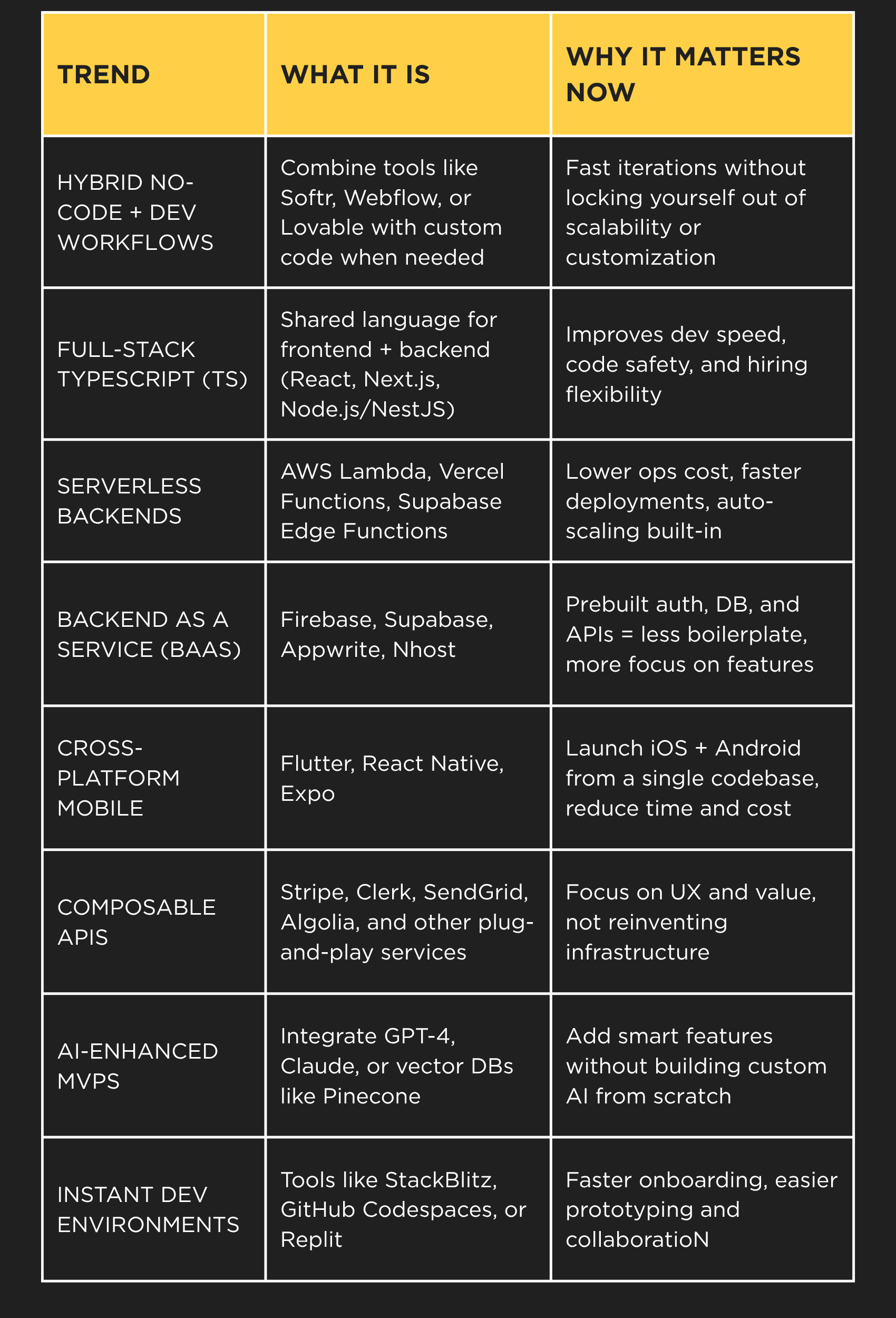What Is the Best Tech Stack for an MVP in 2025?
We’ve talked about MVPs before (how to scope them, build them fast, and validate ideas without wasting months). But this time, we’re focusing on one specific question: what’s the best tech stack for an MVP in 2025?
Because let’s be brutally honest: ideas are cheap, execution is everything. And the tools you choose will either accelerate you or slow you down. So if you’re building something right now (or about to) this guide breaks down exactly what stacks are working right now, and why.
What is an MVP, and why your tech stack matters
An MVP (Minimum Viable Product) is your first working version that proves the core hypothesis of your product. It’s about validation, speed, feedback loops.
Choosing the right tech stack for your MVP in 2025 is critical: get it wrong, and you waste effort. Get it right, and you can scale smoothly or pivot without painful rewrites.
In 2025, the best stack balances three things: speed, flexibility, and future-proofing.
Key criteria for choosing your MVP tech stack in 2025
Before you pick frameworks or languages, filter options through these must‑haves:
1️⃣ Time to market: you need tools, frameworks, and services that let you ship fast. Boilerplate, scaffolding, or no-code/low-code tools may help.
2️⃣ Talent availability & community: in 2025, choose stacks where hiring is easy and the ecosystem is active. A strong developer community means more shared knowledge, open-source contributions, bug fixes, and plug‑and‑play components. Ideally, it’s a community that not only solves problems but invites you to contribute and grow with it.
3️⃣ Cost (development + maintenance): open source, generous free tiers, and minimal ops burden make your life easier early on.
4️⃣ Scalability & flexibility: your MVP may succeed. The stack must grow with you—or at least allow migration paths.
5️⃣ Integration & ecosystem: APIs, services, libraries, SDKs — everything you need should plug in without wrestling.
6️⃣ Security & operations: built-in patterns for authentication, authorization, data protection, and deployment help reduce risks.
What’s trending in 2025 for MVP tech stacks
Let’s look at what modern builders are favoring right now.
No-code + “vibe coding” hybrids
Some teams skip custom code at the start. Tools like Lovable turn Figma designs into React code, letting you iterate fast with fewer bugs.
These hybrid setups let non‑technical founders or lean teams get to market fast — and later migrate parts to custom code as needed. Tools like Lovable, for example, can turn Figma designs into React components, bridging design and development.
Full-stack JavaScript / TypeScript
The “one language across front and back” model continues to dominate. MERN (MongoDB, Express, React, Node) is still a favorite. Using TypeScript throughout enhances safety and maintainability.
Serverless & managed backend
Using FaaS (Functions as a Service) or “backend as a service” (Bearer, Supabase, Firebase) cuts down operations overhead. You focus on logic, not servers.
Popular tools include:
- Supabase – full backend: Postgres DB, auth, storage, and instant APIs.
- Firebase – real-time database, auth, hosting, and serverless functions.
- AWS Lambda – run backend functions on demand, pay-per-use.
- Vercel Functions / Cloudflare Workers – perfect for lightweight APIs close to the edge.
- Auth0 / Clerk – plug-and-play authentication and user management.
For simple MVPs, you can lean heavily on serverless functions, authentication-as-a-service, and managed databases. That means less time on DevOps, more on validating your product.
Cross-platform mobile frameworks
If your MVP must run on mobile (iOS + Android), Flutter or React Native still dominate. You avoid building and maintaining two full native stacks, ideal for early-stage products.
That said, this approach has limits: if your app needs deep integration with the OS, access to native hardware features (like Bluetooth, sensors, or camera pipelines), or targets devices like smartwatches, TVs, or embedded systems, native development may still be required.
But for 80% of MVPs, cross-platform gets you there faster with one codebase and faster iteration.
Hybrid stacks combining no-code + custom code
Start with no-code for landing pages or simple flows, and reserve custom code for core logic or infrastructure. Use wrappers or adapt modules gradually.

Example MVP stacks for specific scenarios
Here are stacks that work well in 2025 depending on your context:
Web SaaS MVP / admin dashboard
- Frontend: React + Next.js (with TypeScript)
- API/Backend: Node.js (Express or NestJS)
- Database: PostgreSQL or MongoDB
- Hosting/Infrastructure: Vercel / AWS Lambda / Supabase
- Auth / Payments / Storage: Auth0, Stripe, S3 / Storage API
This full-JS approach lets you stay lean and reuse types, models, validation logic.
Mobile-first MVP
- Cross-platform: React Native or Flutter
- Backend: serverless functions (Node.js or Deno)
- Database: Firebase or Supabase
- APIs / integrations: use SDKs from Stripe, SendGrid, etc.
You get a single cross-platform app, integrated backend, and fast iteration.
Data-heavy / AI-powered MVP
- Core logic: Python backend (FastAPI, Flask)
- AI / ML: leverage existing models, APIs, or frameworks like LangChain. Use providers like OpenAI API, Hugging Face, or Replicate to access pre-trained models without building your own from scratch.
- Vector DB or specialized DB (e.g. Pinecone, Weaviate)
- Frontend: React or Next.js + TypeScript
- Ops: use container + serverless hybrid
When your product revolves around intelligent or data workflows, combining Python (for ML) with modern frontend tech is still solid.
Pitfalls to avoid in 2025’s MVP journey
🔴 Don’t overengineer. MVP means minimal features, not perfect architecture.
🔴 Don’t pick trendy tech nobody in your team knows.
🔴 Don’t forget basic ops: logging, error tracking, backups.
🔴 Don’t lock-in to services you can’t replace later.
🔴 Don’t build your whole product in no-code—leave room to swap parts.
Migration & “future-proofing” strategies
You will outgrow part of your MVP. Plan ahead:
🟢 Decouple features: make modules independent.
🟢 Use APIs or GraphQL so you can replace backend pieces without rewriting front-end clients.
🟢 Maintain clean data models and migrations.
🟢 Use interfaces or abstraction so service implementations can be swapped.
🟢 Keep data export/import easy.
🟢 Infrastructure as Code (Terraform, Pulumi).
How to pick your best tech stack for your MVP
Here’s a step-by-step:
1️⃣ List must-have features: define your MVP scope (login, dashboard, payments, etc.).
2️⃣ Pick frontend and mobile constraints: web only? mobile? both?
3️⃣ Select backend style: serverless, monolithic, microservices?
4️⃣ Choose database type: relational vs document vs hybrid.
5️⃣ Map integrations: payments, email, analytics, etc.
6️⃣ Score trade-offs: speed, cost, flexibility.
7️⃣ Validate with your team’s skills: tech must be maintainable by your team or the team you can hire.
8️⃣ Prototype the core flow: build the critical user journey first, see where tech constraints bite, adjust early.
So, what is the best tech stack for an MVP in 2025?
There is no single “best” stack. The best for you is the one that balances:
- Speed (ship quickly)
- Risk minimization (avoid complex dependencies)
- Scalability (so you don’t rebuild everything)
- Developer efficiency (your team must move fast)
In 2025, that often means a hybrid between managed services / serverless + modern frontend frameworks + cross-platform mobile (if needed). Use no-code or vibe-coded solutions where it makes sense. Favor TypeScript / JavaScript full-stack or Python + JS combo when necessary. Build for migration.
And if you need any advice, Acid Tango is here to help you.
FAQs – MVP Tech Stack 2025
What is the fastest tech stack to build an MVP in 2025?
A full-stack TypeScript setup using Next.js for the frontend and Supabase or Firebase for the backend is one of the fastest options. It offers built-in auth, database, API routes, and hosting with minimal configuration.
Should I use no-code tools for my MVP?
Yes, if speed is your priority. Tools like Webflow, Softr, or Bubble help you launch quickly without writing code. However, for complex logic or long-term scaling, custom development will eventually be necessary.
Is serverless still relevant for MVPs in 2025?
Definitely. Serverless architectures are ideal for MVPs—they reduce infrastructure overhead, scale automatically, and integrate smoothly with modern frontend frameworks.
Which database is best for MVPs?
It depends on your use case:
- Use PostgreSQL for structured, relational data (great with Supabase or Neon).
- Use Firebase or MongoDB for flexible schemas or real-time features.
What if I want to build a mobile app first?
React Native and Flutter are the top choices for cross-platform development. Pair them with Firebase or Supabase to handle backend services like authentication, data, and storage.
Can I switch stacks later if my MVP grows?
Yes, as long as you plan for it. Use APIs to isolate features, avoid tight coupling between frontend and backend, and make sure your data is easy to migrate. Many successful products rebuild parts of their stack as they grow.
